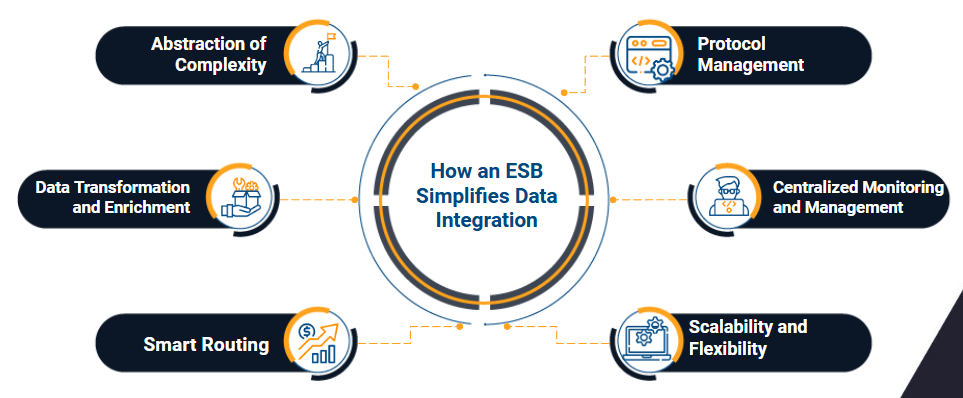
-100.jpg)
How does an ESB simplify data integration?
July 31, 2024
Table of contents
Quick Access
In the modern technology world, data integration has become a fundamental pillar for efficient business operations. Data comes from various sources and must be processed, transformed, and directed to multiple destinations. This complex process requires a solution that is robust, scalable, and efficient. This is where the Enterprise Service Bus (ESB) comes into play.
This article will explore how an ESB simplifies data integration, providing a technical and detailed overview aimed at professionals and engineers in the sector.

What is an ESB?
An Enterprise Service Bus (ESB) is a software architecture that facilitates communication between different applications in a distributed systems environment. It acts as a middleman, allowing various applications to interact with each other without the need for direct point-to-point connections. Instead of each application having to know the specifications and protocols of all the others, they connect to the ESB, which handles message translation, routing, and mediation.
The Complexity of Data Integration
Data integration in an enterprise environment involves the movement, transformation, and consolidation of data from multiple sources to multiple destinations. Without a proper mechanism, this process can be extremely complex due to:
- Diversity of Data Sources: Modern enterprises handle data from enterprise applications, databases, web services, legacy systems, and more.
- Different Data Formats: Data can be in different formats such as XML, JSON, CSV, etc.
- Communication Protocols: Applications can communicate using different protocols such as HTTP, FTP, and JMS, among others.
- Data Transformation: Data must be transformed to meet the requirements of the target system.

How an ESB Simplifies Data Integration
1. Abstraction of Complexity
The ESB provides an abstraction layer that hides the complexity of communications between applications. Instead of developing specific interfaces for each integration, applications only need to know how to communicate with the ESB. This significantly reduces the workload and potential errors.
2. Data Transformation and Enrichment
An ESB facilitates the transformation of data between different formats using built-in transformation components. For example, it can convert an XML message to JSON before sending it to the final destination. In addition, the ESB can enrich the data, adding additional information necessary for processing.
3. Intelligent Routing
The ESB uses routing rules to direct messages to the correct destinations based on their content or other predefined conditions. This ensures that data reaches the right systems without the need to code complex logic in each application.
4. Protocol Management
Applications can communicate using different protocols and the ESB acts as a universal translator. This allows applications to interact without worrying about protocol incompatibilities.

5. Centralized Monitoring and Management
The ESB provides tools for centralized monitoring and management of data traffic. This allows administrators to have a complete overview of data flows, identify bottlenecks, and resolve problems quickly.
6. Scalability and Flexibility
The ESB is designed to be scalable, meaning it can handle increasing volumes of data and connections as the business grows. In addition, its modular architecture allows for adding new functionality and adapting to new requirements without affecting the functioning of existing integrations.
7. Reduced Costs and Development Times
By reducing the complexity of point-to-point integrations, an ESB reduces the costs associated with developing and maintaining specific interfaces. This not only reduces development time but also the total cost of ownership (TCO).

ESB Data Integration Use Cases
Enterprise Application Integration
Large enterprises use multiple enterprise applications such as ERP, CRM, and inventory management systems. An ESB can integrate these systems, allowing them to share data in real-time and streamline business processes.
Data Synchronization Between Databases
In environments where multiple databases must be kept in sync, an ESB facilitates automatic synchronization, ensuring that changes in one database are immediately reflected in the others.
Cloud Service Integration
With the increasing adoption of cloud services, enterprises need to integrate their on-premise systems with cloud applications. An ESB facilitates this integration, managing protocol and data format differences between on-premise systems and cloud services.
Data integration is a critical challenge for modern enterprises, and an ESB provides an effective solution to simplify this process. By abstracting complexity, handling data transformation, facilitating intelligent routing, and providing centralized monitoring tools, the ESB enables companies to integrate their systems more efficiently and effectively. This not only improves interoperability and business agility but also reduces development costs and time.
For professionals and engineers in the technology field, understanding and using an ESB is key to addressing the challenges of data integration in an increasingly complex and diversified business environment.
We recommend you on video
Related Blogs

How Atlassian is transforming enterprise collaboration with Jira, Confluence and Trello

Guide: Drupal Development Services for Businesses

Using Akismet in Drupal 10: Protect Your Forms from Spam

How to Create a Simple Drupal Webform?

How to Find a Drupal Development Company?
